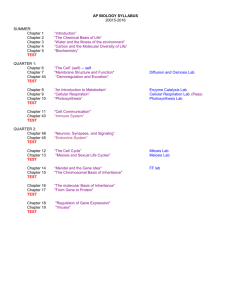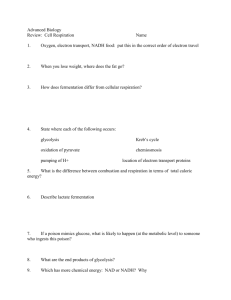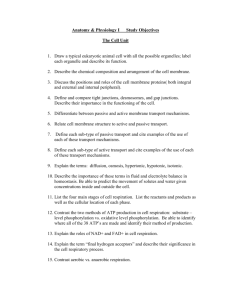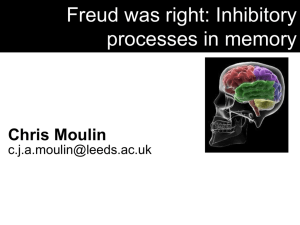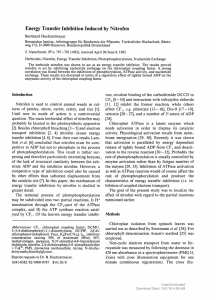AP Biology final review sheet 05
advertisement
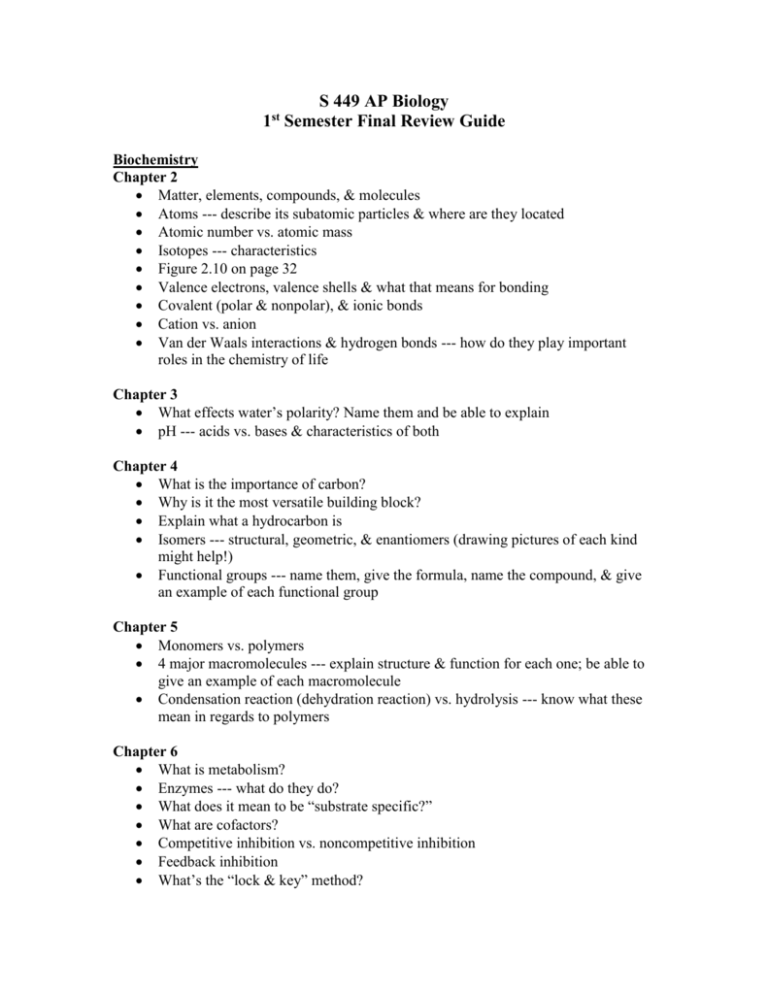
S 449 AP Biology 1 Semester Final Review Guide st Biochemistry Chapter 2 Matter, elements, compounds, & molecules Atoms --- describe its subatomic particles & where are they located Atomic number vs. atomic mass Isotopes --- characteristics Figure 2.10 on page 32 Valence electrons, valence shells & what that means for bonding Covalent (polar & nonpolar), & ionic bonds Cation vs. anion Van der Waals interactions & hydrogen bonds --- how do they play important roles in the chemistry of life Chapter 3 What effects water’s polarity? Name them and be able to explain pH --- acids vs. bases & characteristics of both Chapter 4 What is the importance of carbon? Why is it the most versatile building block? Explain what a hydrocarbon is Isomers --- structural, geometric, & enantiomers (drawing pictures of each kind might help!) Functional groups --- name them, give the formula, name the compound, & give an example of each functional group Chapter 5 Monomers vs. polymers 4 major macromolecules --- explain structure & function for each one; be able to give an example of each macromolecule Condensation reaction (dehydration reaction) vs. hydrolysis --- know what these mean in regards to polymers Chapter 6 What is metabolism? Enzymes --- what do they do? What does it mean to be “substrate specific?” What are cofactors? Competitive inhibition vs. noncompetitive inhibition Feedback inhibition What’s the “lock & key” method? Allosteric sites --- what are they? What are some physical & chemical environmental factors that effect enzymes? The Cell Chapter 7 Why do we use microscopes? Prokaryotic vs. Eukaryotic cells Describe & explain functions of the following: Nucleus & ribosomes Endomembrane system Mitochondrion & chloroplasts Cytoskeleton --- the 3 types Cell surface & junctions What are peroxisomes? Chapter 8 Fluid mosaic model Selectively permeable Describe the structure and function of the cell membranes Exocytosis vs. endocytosis --- receptor-mediated endocytosis Phagocytosis vs. pinocytosis Diffusion vs. osmosis Passive vs. active transport Solutions --- hypertonic, hypotonic, isotonic --- what happens with each type of solution? Ecology Chapter 50 Abiotic vs. biotic factors --- how do these affect the distribution of organisms? Organismal, population, community, landscape ecology What factors affect the distribution of organisms? What are some problems that introduced species can create? (Be able to give some examples) What is vertical stratification? Why is this important? Oligotrophic vs. eutrophic lakes What is allocation? Why is this important to ecology? Chapter 52 What are the 2 most important characteristics of any population? What are the 3 types of dispersion? Which one is the most common? How can you measure density? (Be able to do the equation for this method that we talked about) What are the 3 types of survivorship curves? (Figure 52.3 on page 1155) What is carrying capacity? Density-independent vs. density-dependent factors --- how do these affect populations? What is a country’s age structure? (Graphs on page 1170) Chapter 53 What is a community? Individualistic hypothesis vs. interactive hypothesis --- know what each hypothesis states Population interactions --- intraspecific competition vs. interspecific competition What is coevolution? What are some plant defenses vs. predators? What are some animal defenses vs. predators? What is an ecological niche? What is character displacement? Dominant species vs. keystone species Primary succession vs. secondary succession Biodiversity --- species richness vs. relative abundance --- how are these components of biodiversity? What is symbiosis? What are the 3 types of symbiotic relationships? What is biogeography? Chapter 54 Vocabulary --- heterotrophs, autotrophs, primary producers, primary consumers, secondary & tertiary consumers, detritivores What is an ecosystem? What is primary production in an ecosystem? What is GPP & NPP? How is the human population affecting ecosystems and the biosphere? What is biological magnification? Chapter 55 What does conservation science deal with? What is the single greatest threat to global diversity? What effects do introduced species have on biological communities? (positively & negatively) Evolutionary History Chapter 26 Figure 26.1 on page 511 Biogenesis vs. spontaneous generation --- Pasteur’s experiment on page 517 Miller-Urey’s experiment History of life --- timeline (page 524 summary) Chapter 27 Gram-positive vs. gram-negative bacteria --- characteristics of both (page 529) Read the chapter 27 review on page 543 Chapter 28 The model of the origin of eukaryotes What is endosymbiosis? Read the chapter 28 review on page 573 Respiration and Photosynthesis Chapter 9 Overall reaction for respiration Compare aerobic and anaerobic respiration Substrate level phosphorylation/Oxidative phosphorylation Glycolysis-starting materials, end product, where does it occur, ATP, NADH, etc. Krebs Cycle-starting materials, end products, where does it occur, ATP, NADH, FADH2, etc. ETC-describe what happens What is chemiosmosis? Diagrams p. 161, 166, 168, 169 Chapter 10 Overall reaction for photosynthesis Parts of a chloroplast Light reactions-Photosystem I and Photosystem II Dark reactions-3 phases of the Calvin cycle and what happens in each phase Photorespiration-CAM plants, C3, C4 plants Diagrams p. 180, 186, 189 Plants Chapter 29 Alternation of generations-diagram p. 580 Evolution of Charophyceans to Angiosperms-which generation is dominant in each? Vascular tissue? How do they reproduce? Sporophyte/Gametophyte Chapter 30 Examples of angiosperms and gymnosperms Flower parts-male and female Diagram p. 598 Chapter 35 Monocot/dicot diagram p. 721 Roots, stems, leaves, flowers-functions Types of meristems Chapter 36 Transpiration-what affects it? Think about the lab. How is it controlled? Chapter 37 Nitrogen as a plant nutrient Symbiosis of plants and soil microbes Chapter 38 Pollination Fertilization-also double fertilization Asexual reproduction Chapter 39 Hormones-auxin, cytokinin, gibberellins, abscisic acid, ethylene-what do they do? Short day/Long day plants Tropisms Plant defenses Animal Diversity Chapter 32 What is an animal? Protostome/Deuterostome Blastula, cleavage, etc. Diagram p. 634, 636 Chapter 33 Phyla-Porifera, Cnidaria, Platyhelminthes, Nematoda, Mollusca, Annelida, Arthropoda, Echinodermata, Chordata Characteristics of phyla including symmetry, body cavity, germ layers, protostome/deuterostome, etc. Chapter 34 Arthropod classes-Arachnida, Insecta, Crustacea General characteristics of chordates Chordate classes, Subphylum Vertebrata-Amphibia, Reptilia, Aves, Mammalia, Chondrichtheyes, Osteichthyes, Agnatha, Why is the amniotic egg so important?






